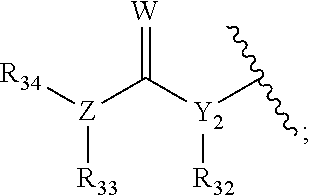Hedgehog antagonists having zinc binding moieties
- Summary
- Abstract
- Description
- Claims
- Application Information
AI Technical Summary
Benefits of technology
Problems solved by technology
Method used
Image
Examples
example 1
Preparation of (E)-2-chloro-N-(4-chloro-3-(5-(3-(hydroxyamino)-3-oxoprop-1-enyl)pyridin-2-yl)phenyl)-4-(methylsulfonyl)benzamide (compound 1)
Step 1a. (E)-Methyl 3-(6-bromopyridin-3-yl)acrylate (compound 1001-1)
[0170]A mixture of 6-bromonicotinaldehyde (500 mg, 2.7 mmol) and methyl (triphenylphosphoranylidene) (1 g, 3.2 mmol) in dichloromethane (10 mL) was stirred at room temperature for 1 h. The mixture was concentrated in vacuo and filtered. The solid was washed with hexanes to afford crude compound 1001-1 as a white solid (1.5 g).
Step 1b. (E)-Methyl-3-(6-(2-chloro-5-(2-chloro-4-(methylsulfonyl)benzamido)phenyl)pyridin-3-yl)acrylate (1002-1)
[0171]A mixture of 1001 (121 mg, 0.5 mmol), 1-9 (200 mg, 0.4 mmol), Pd(PPh3)2Cl2 (30 mg) in 1,4-dioxane (6 mL) and aq NaHCO3 (2 mL) was stirred at 110° C. for 3 h under N2. After cooling to room temperature, the reaction mixture was quenched with water, extracted with ethyl acetate. The combined organic layers were washed with water and brine, d...
example 2
Preparation of 6-(2-Chloro-5-(2-chloro-4-(methylsulfonyl)benzamido)phenyl)-N-hydroxynicotinamide (compound 5)
Step 2a. Methyl 6-bromonicotinate (compound 1001-5)
[0174]To a solution of 6-bromonicotinic acid (500 mg, 2.5 mmol) in dichloromethane (10 mL) and THF (5 mL) was added oxalyl chloride (1.4 mL, 0.016 mol) followed by addition of one drop of DMF. The mixture was stirred at room temperature for 1 h. After removal of solvent, the residue was dissolved in anhydrous methanol (5 mL) and continued to stir for 10 min. The reaction mixture was quenched with ice water and filtered to afford 1001-5 as a pale yellow solid (212 mg, 40%). LCMS: m / z 213.1 [M+1]+. 1H NMR (400 MHz, CDCl3): δ 3.96 (s, 3H), 7.42 (d, J=8.4 Hz, 1H), 8.25 (dd, J=8.0 Hz, 2.0 Hz, 1H), 9.00 (d, J=2.0 Hz, 1H).
Step 2b. Methyl 6-(2-chloro-5-(2-chloro-4-(methylsulfonyl)benzamido)phenyl)nicotinate (compound 1002-5)
[0175]A mixture of compound 1001-5 (200 mg, 0.9 mmol), 1-9 (367 mg, 0.8 mmol) and Pd(PPh3)4 (21 mg, 0.018 mmol)...
example 3
Preparation of 2-[2-Chloro-5-(2-chloro-4-methanesulfonyl-benzoylamino)-phenyl]-pyrimidine-5-carboxylic acid hydroxyamide (compound 7)
Step 3a. 2-Chloro-pyrimidine-5-carboxylic acid methyl ester (compound 1001-7)
[0177]A mixture of NaH (27 g, 60% in mineral oil, 0.675 mol) in anhydrous 1,2-dimethoxyethane (300 mL) was heated to 40-50° C. Methyl 3,3-dimethoxy propionate (100 g, 0.675 mol) was added dropwise. The resulting mixture was stirred for 0.5 h and anhydrous methyl formate (81 g, 1.35 mol) was added dropwise at 40-50° C. The resulting mixture was stirred at 40-50° C. (inner temperature) for 2 h before it was cooled to 0° C. The reaction mixture was allowed to warm to 25° C. slowly and stirred overnight. Et2O (150 mL) was added and stirred for 30 min. The resulting suspension was filtered. The solid was washed with Et2O (100 mL), collected and dried to afford sodium (Z)-2-(dimethoxymethyl)-3-methoxy-3-oxoprop-1-en-1-olate as an off-white solid (82 g, 61%). LCMS: m / z 130.8 [M+1]+. ...
PUM
| Property | Measurement | Unit |
|---|---|---|
| Composition | aaaaa | aaaaa |
| Bond | aaaaa | aaaaa |
Abstract
Description
Claims
Application Information
 Login to View More
Login to View More - R&D
- Intellectual Property
- Life Sciences
- Materials
- Tech Scout
- Unparalleled Data Quality
- Higher Quality Content
- 60% Fewer Hallucinations
Browse by: Latest US Patents, China's latest patents, Technical Efficacy Thesaurus, Application Domain, Technology Topic, Popular Technical Reports.
© 2025 PatSnap. All rights reserved.Legal|Privacy policy|Modern Slavery Act Transparency Statement|Sitemap|About US| Contact US: help@patsnap.com



